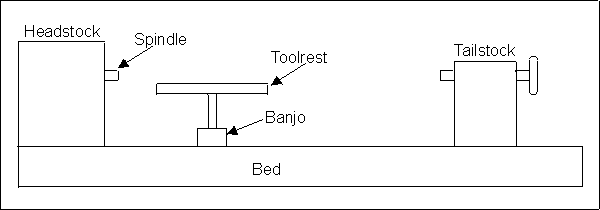| Main page | Læs denne side på dansk |

|
The wood lathe
I here give a short introduction to the different parts of a typical wood lathe made from metal. The illustration below shows a schematical drawing of a wood lathe:
The headstock is the most important part of the lathe. Here is the motor and the revolving spindle that makes the wood rotate. At least the right side of the spindle protrudes a little and has usually a thread on the outer of the end, used for mounting acessories to hold the wood. The thread varies between lathes, limiting the use of acessories between lathe models. Though, in many cases you can buy adaptors which are convenient if you have lathes with different thread.
The spindle is often hollow with a hole though the whole length. The hole is tapered in the right end, called a 'Morse Taper' (MT). The size of the morse taper is usually in one of three standard sizes: MT1, MT2 or MT3. MT2 is the most common, MT1 is found on a few small lathes and MT3 mainly on big lathes.
On a few lathes there is also a thread and/or morse taper on the left end of the spindle for turning wood of larger diameter.
The spindle may have a locking mechanism to lock it at certain angles, mainly used for decorating the turned item at regular angular intervals.
The headstock is usually fixed to the bed, which is the main, bearing part of the lathe. On some lathes, the headstock can rotate so that the spindle is perpendicular to the bed allowing for turning wood of a larger diameter than would fith over the bed. On some lathes, the headstock can move along the bed.
The motor can be placed in different locations. Most common is to have the motor behind the headstock but it can also be placed under the bed or integrated in the headstock, maybe even with the spindle as the motor shaft. Ususally, the motor is connected to the spindle by a belt drive with a number of pulleys in different sizes on the motor shaft and on the spindle so that the spindle speed can be changed by moving the belt between the pulleys. Before moving the belt, the tension has to be released. The belt can be tensioned in different ways, e.g. by a separate movable wheel presseing against and tensioning the belt or by having the motor mounted on a hinge mechanism, so that the motor can be moved to adjust the tension. Normally, the pulleys are placed behind a door for security reasons.
The power switch for the motor is also usually located on the headstock. There may also be an electronic speed control and forward/reverse switch for the motor. The speed control (and power switch) can be placed in a small movable box, that can be placed with magnets so that it is easy to reach from the actual working position.
The motor may be single-phase so that it can be pugged into a normal power outlet, or it may use three phases requiring a special power outlet. For an old lathe with a three phase motor you may buy an electronic speed control unit, that converts single phase current to three phases with variable speed.
Some lathes have a mechanical speed control with a lever adjusting the diameter of the pulley on the spindle.
The bed is most often made from two parallel steel tubes or cast iron. The bed is the carrying part of the lathe with the headstock in the left end, the tailstock in the right end and the banjo with the toolrest moving along the bed inbetween. The banjo can be moved forth and back, left and right and rotated to position the toolrest where needed. The absolutely most convenient is if the banjo is locked with a lever at it's end, but on some older or cheaper lathes you have to tighten a nut with a tool under the bed.
The toolrest can be moved up and down in the banjo. It is absolutely also most convenient if it is locked with a simple handle, preferably with a handle, that can be rotated after locking the toolrest to move it to the least disturbing position. The toolrest itself is a horizontal metal bar welded to a column.
The tailstock on the right end of the bed is used to support long or heavy pieces of wood. The tailstock can be moved along the bed so that it is close to the wood. It is often locked with a lever, but it isn't moved that often, so it is less important how easy it is to move. The tailstock has a shaft similar to the spindle (but not rotating). Instead, the tailstock shaft can be moved along it's axis towards or away from the spindle. It has a morse taper in the end towards the headstock and usually also a hole the whole way through.
Usually, the tailstock is used to support the wood using a conical tip held in the morse taper, called a centre. The centre may be steady or (much better) revolving with the wood. A revolving centre is called a live centre.
This was a short description of the basic elemnts of the most common wood lathe.
Go on to 'Techniques for holding the wood'
Back to 'Introduction to woodturning techniques'
Main page
Back to 'Introduction to woodturning techniques'
Main page
| Search my site: |
Copyright: You are welcome to copy and use photos and text for non-commercial purposes if you inform me first and make a comment with my name as reference next to the material copied.